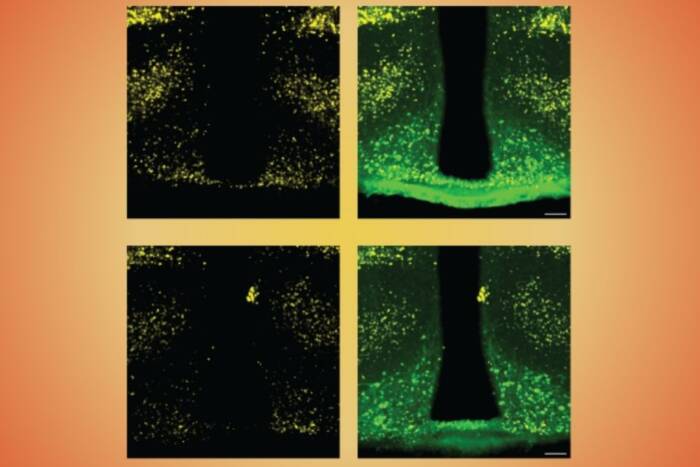Rockefeller’s newest faculty member studies birdsong to illuminate the origins of human language
The ability to speak has allowed our species to pass knowledge between generations, articulate complex ideas, and build societies. Erich Jarvis, the newest addition to Rockefeller’s faculty, uses songbirds as a model to study the molecular mechanisms that underlie how individuals learn spoken language.

Erich Jarvis will be joining Rockefeller this fall.
Jarvis, currently a tenured professor at Duke University, will join Rockefeller as a tenured professor and head of laboratory this fall. His work focuses on how songbirds learn to vocalize, including how their brains, and ours, have evolved to produce this complex behavior. The vast majority of animals—including common model organisms like mice and fruit flies—cannot imitate sounds, limiting their usefulness in the study of vocal learning. To advance research in this field, Jarvis has developed a suite of molecular and computational tools for songbirds, paving the way for many contributions to our understanding of the evolution and neural mechanisms of spoken language.
“Why are we more capable than other species of having spoken language?” asks Jarvis. “You can teach many animals to learn the meaning of human words that they hear, like telling a dog to sit, but they can’t learn to imitate and produce those words; they have auditory learning, but they don’t have vocal learning. I’m fascinated by vocal learning because it’s the main component of language that gives us this specialized ability.”
Avian investigations
A Bronx native, Jarvis had an artistic upbringing. He was trained as a dancer and musician, but after studying biology and mathematics at Hunter College, his fascination with consciousness and language led him to Fernando Nottebohm’s laboratory at Rockefeller, where he was introduced to the songbird as a model for vocal learning. Jarvis earned his Ph.D. in 1995 and continued postdoctoral studies in Nottebohm’s laboratory, examining genes linked to vocalization in the canary forebrain.
In 1998, Jarvis joined Duke University as assistant professor, where he launched his own laboratory devoted to research on vocal learning in several types of birds, including songbirds, parrots, and hummingbirds. He was promoted to associate professor in 2005 and to professor in 2016. He was named a Howard Hughes Medical Institute investigator in 2008.
At Duke, Jarvis and his collaborators conducted comparative studies between species, looking at brain anatomy and gene expression patterns. Findings from this work suggest that the brain pathways for vocal learning are located within parts of the brain also responsible for body movements, called motor circuits. These results led Jarvis to propose a new theory: that motor circuits are key to the origin of vocal learning, and that the brain pathways that underlie vocal learning in birds and humans evolved from an existing motor learning circuit that was common to all vertebrates.
Jarvis’s findings have significant implications, suggesting that an entire body of work in songbirds—including research from Nottebohm and from Rockefeller’s Peter Marler—has direct relevance to humans. Research from Nottebohm and Marler had shown that songbirds had vocal learning behavior similar to humans, and a specialized brain circuit for that behavior, but their findings stopped short of identifying direct links to specific brain regions or genes in humans. Jarvis’s work with the gene FoxP2, the first gene shown to be required for speech acquisition in humans, found that it is turned on and off during critical periods of vocal learning, and that it plays an important role in song-learning in songbirds. (This work was done in collaboration with Constance Scharff, also a Rockefeller alumnus of the Nottebohm lab.)
Jarvis has also established himself as an international figure within the neuroscience community. Shortly after joining Duke, he co-led a forum to update outdated avian brain terminology, which had persistent errors that were hindering communication between scientists and wrongfully preventing comparisons between the avian and human brain. The consensus reached by this initiative eventually resulted in a new understanding of vertebrate brain evolution and a complete revision of avian forebrain anatomy that the neuroscience community has since adopted.
Jarvis has since co-led another international project, a consortium of over 200 scientists, from 101 institutions in 20 countries, to sequence the genomes of one bird species from each avian order, a total of 48, many of which are not capable of vocal learning. This consortium has published over 50 papers, and has led to an overhaul of the bird family tree, rewriting the history of how vocal learning evolved in birds. Jarvis’s and his colleagues’ findings from this work suggest that vocal learning evolved at least twice among birds, in fact, once in hummingbirds and once in a common ancestor of songbirds and parrots.
Jarvis’s subsequent analysis of these genomes revealed that not only FoxP2, but hundreds of genes, are similarly involved in both the song-learning circuits of songbirds and the speech circuits of humans, and that many of the changes to these genes are not found in the brains of their close living relatives. Some of these genes, when mutated, are associated with speech disorders in humans, and are predicted by Jarvis’s studies to control the development of speech brain circuits.
Jarvis lab at Rockefeller
As he makes his transition to Rockefeller, Jarvis will focus on the molecules that guide neuronal connections from motor learning pathways to vocal neurons, called axon guidance molecules. He hypothesizes that these molecules make the difference between a vocal learner and non-learner because they guide the creation of a crucial neural circuit for vocal learning.
“The presence or absence of a particular neural circuit is what I propose is the key to vocal learning,” says Jarvis. “This extra circuit is connected to the vocal organs, and is embedded within the motor pathway that controls learning how to move. This allows finer motor control of your larynx, to produce imitated speech—and we predict that it’s the axon guidance molecules that make that difference, because they are what controls that connectivity.”
Manipulating these molecules could either prevent vocal learning or enhance it. One of Jarvis’s long-term goals is to use these molecules to induce a vocal learning circuit in a species that can’t normally imitate speech, such as a mouse.
Another aspiration is to paint a complete picture of how all vocal learning and vocal non-learning species are related to one another by continuing to sequence the genomes of different species. Eventually, Jarvis would like to sequence all vertebrates. “Like many others, I’ve realized the power of genomics,” he says. “Although it’s broken down into several phases, it’s a very ambitious project, because there are 10,500 bird species, and over 66,000 vertebrates total. But the more species you have, the more accurate your genetic family trees are, and the more you can discover about the evolution of traits.”
“Erich has built a phenomenal research program over the past 18 years, driven by a desire to understand the role that genetics play in a complex learned behavior that is shared among only a few species,” says Marc Tessier-Lavigne, the university’s president. “His work, which continues a tradition that began at Rockefeller some 50 years ago under Peter Marler, has led to a wholesale reevaluation of how vocal learning evolved. And it continues to yield surprising results, harnessing modern techniques in genetic sequencing to explain how neural circuits form during learning. It is fitting that his research will continue at Rockefeller, and it is a pleasure to welcome him back.”


